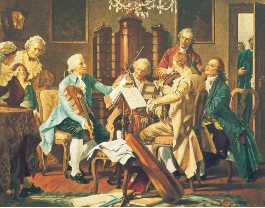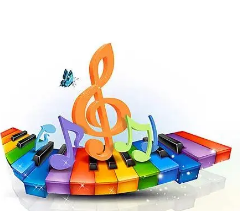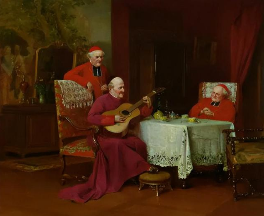Everything Sounds The history of Western Music in ten minutes
10 min read
The best of art is expressed through music, which can resonate in different countries, races and people. In the longer term, an understanding of the art of music can enhance an individual’s desire to know more about his or her own humanity. Music with its limited seven notes and twelve notes, arranged and combined into a beautiful melody, together into an inexhaustible flow of life. It can be said that of all the arts, there is no art that more directly expresses the inner emotions of people than music.
Every civilization is the comprehensive embodiment of human conquest of the world, and classical music is the miracle of human civilization. Now please follow the guidance of friends, together through this magnificent long river of classical music history development.
I. Enlightenment of Human Civilization: Music of Ancient Greece and Rome c. 600 BC – C. 600 BC.
The art of music in Western civilization began about 3,000 years ago in ancient Greece. Archaeologists found musical records from around the first century A.D. on a gravestone and restored the Greek words on the stone into a song. This is the earliest music known as the Song of Secylus.
The music system of ancient Greece, after centuries of cultivation, has had a wide and far-reaching influence on the later generations. The most obvious symbol is the lyre, which now symbolizes music and is used as the “emblem”.
The music of ancient Rome has been part of Roman culture since ancient times. Songs are an essential part of almost every social occasion. The music of ancient Rome is the same as its culture, mainly inheriting the culture and music of ancient Greece.
The biggest difference between ancient Rome and ancient Greece is that there were many battles in ancient Rome. In order to celebrate victory, brass instruments were greatly developed. Despite their legendary lack of musical creativity, the Romans loved music and used it in many activities and religious ceremonies as a sign of education.
Echoes Through the Mists: The Middle Ages and the Renaissance C. 600 – C. 1600.
Historians use the term “Middle Ages” to describe the thousand years of history between the fall of the Roman Empire and the discovery of the New World. The Middle Ages now seem like a very long time ago.
It was a time of monks and nuns, knights and wars, plagues of lofty spirits and death, and towering cathedrals surrounded by terrible poverty. It is interspersed with splendid architecture, exquisitely decorated glass, and equally enchanting poetry and music.
Medieval music can be divided into two simple types: religious music and secular music. The former consisted mainly of monophonic Gregorian chant, and later developed polyphonic music such as Olganon and verses, all of which were inseparable from religious activities; The latter consisted mainly of common instrumental music and folk songs, which were also spread and sung by certain groups of people, such as troubadours.
Legend has it that around A.D. 600, a dove landed on Pope Gregory’s shoulder and taught him a piece of music. This was the origin of Western art music, or “classical music”.
After centuries of accumulation, Renaissance music showed a more complex and diverse trend. The music had measurable rhythms, adopted mediamode, which had been expanded to 12 modes, and also had a tentative attempt at harmonic function.
Musical “Renaissance” refers to the development of music between 1475 and 1600. It appeared in Italy, France, England. The most significant development is the close connection between music and lyrics. Renaissance composers began to write secular music for the home as well as traditional religious music for the church.
In the process of appreciating early music, we will inevitably encounter some blind spots, which will limit our understanding of the music. In fact, this music is extremely valuable to discover, and we are exploring in various ways, getting closer and closer to the truth of history.
Iii. The Flourishing of Reason: The Baroque Period c. 1600 – C. 1750.
If the art and music of the Renaissance were marked by balance and rational control, the art and music of the Baroque period were full of grand, ornate, dramatic colors.
The term “Baroque” is generally used to describe art from 1600 to 1750. The Baroque period was a time of great creativity — from Shakespeare and Cervantes in literature to Newton and Galileo in science, who broke new ground in their fields. As an important part of art, music presents a similar situation.
During the Baroque period, new genres of music developed: opera, cantata, and oratorio entered the realm of vocal music; Sonatas, concertos, and suites are found in the instrumental genre.
The Baroque period witnessed the birth of opera, the development of orchestra and the prosperity of instrumental music, especially the creation and playing skills of violin and keyboard instruments, which made great progress during this period. Most of the new styles of music began in Italy, and many Italian musicians made great contributions. From monophonic songs represented by Monteverdi in the early period to polyphonic music represented by Bach and Handel in the late period.
You may find Baroque polyphony hard to understand, but do you still think so every time the melody of “Canon in D Major” plays in a movie or at a wedding?
4. The Peak of Western Music: The Classical Period c. 1750-1820.
The period 1750-1820 is known as the “Classical period” in music history. This period developed a new and simpler style of music compared to the Baroque period. At its core is clarity, moderation and balance. These ideas reflect the value tendency of culture and art at that time. Since then, the roots of almost every innovation in Western music can be traced back to this period.
During the classical period, instrumental music surpassed vocal music in popularity for the first time. Composers had to experiment with new ways of composing in order to create larger and more complex pieces in response to the increasing demands of audiences.
The piano first entered the public consciousness, gradually supplanted the harpsichord as the preferred keyboard instrument because of its ability to play beautiful phrases with varying forces.
Symphonies of the classical period evolved from the smaller symphonies of the Baroque period, and symphonies underwent fundamental changes during this development, producing an art form that we consider iconic today.
The final symphony usually consists of four movements: the first usually begins with a gripping sonata-like “allegro”; The second movement is usually an adagio movement; The third movement is mostly composed of the elegant minuet, but soon after its establishment, it is replaced by the Scherzo, which is richer in emotional expression. The closing rondo reproduces the theme, repeating it in different tones until it reaches the end.
Other musical genres also developed to varying degrees during the same period, with many styles being redefined:
For example, the three-movement concerto becomes a tool for displaying skills, and the core value of the piece is presented by the virtuosity of the performer. Sonatas, on the other hand, developed into a more rigorous and rigorous form of music, often composed for only one or two instruments. At the same time, the creation and performance requirements of new family music opened up new development space for chamber music, and directly gave birth to brand-new chamber music forms, such as the string quartet invented by Haydn, as well as piano trio and other musical genres.
Every great artist is a member of the age, and together they create the age. Just like the three Viennese masters of the school — Haydn, Mozart and Beethoven, their music set the tone of classical music.
Haydn was born during the Baroque period and was still alive when Beethoven wrote the Pastoral Symphony. Haydn was a key figure in the evolution of the classicist style, establishing standard formal norms for symphonies, sonatas and string quartets. An internationally renowned master of his time, he was a profound influence on Mozart and personally taught Beethoven. He composed an amazing number of symphonies in his life, known as the “father of symphony”.
Still, he knew there was a mountain beyond the mountains. “My friends often call me a genius, but Mozart’s genius is far above mine,” Haydn praised.
Mozart was indeed one of the most incredible musicians of all time, touring all over Europe as a child, which not only made him famous, but also introduced him to more musical styles. He incorporated each of these styles into his compositions.
Mozart’s music covers a wide range, among his many works, opera is the most representative of his style of creation. Mozart created a vivid sound by emphasizing the expressive part of orchestral music and the richness of sound, as well as his extraordinary talent for melody. The subversive effect brought by these elements makes the dramatic effect double the expression, which is unprecedented in opera creation before.
In fact, it breaks down the emotional boundaries between formal opera and comic opera. This is evident in his operas The Marriage of Figaro, Don Giovanni and The Heart of a Woman: the depth of character, the subtlety of psychology and the intricacies of the plot, coupled with the masterful orchestral arrangements, are stunning.
During his short life, Mozart wrote more than 650 pieces of music, including 41 symphonies. The famous Symphony No. 40 in G Minor, one of his last three, was written by Mozart in dire straits. It is a work that alludes to tragedy and despair, and speaks of the composer’s disappointment and loneliness, as well as his premonition of death.
V. A Hundred Schools of Thought Contend: The Romantic Period c. 1820 — 1910.
The 19th century was a very attractive period in the history of western music — the Romantic period, which focused on the inner world and expressed the pursuit of the ideal world. The composers of this period have strong personality, pursue originality, advocate human emotion and instinct, and seek inspiration in nature. Love, poetry, and literature are all the “magic” that gave birth to romantic music.
Many familiar musicians light up the romantic chart: Schubert, Schumann, Liszt, Wagner, Brahms, Berlioz, Rossini, Verdi, Dvorak, Tchaikovsky, etc. A hundred flowers blossom.
During the Romantic period, some of the most skilled performers, such as Liszt, gave the music of the period some unique characteristics. At the same time, the music industry also appeared the trend of music salon, such as Chopin and Schumann short works… As a result, irreconcilable conflicts and contradictions gradually formed between the public works for solo or orchestra by many of the great romantic composers of the time and the solitary “salon music”, such as Schubert’s Winter Journey, forming a clear-cut line.
The status of romantic music in the history of music is self-evident, this period not only abounds in musicians, but also the music genre is unprecedently wide, breaking through the restrictions of classical music structure, the form is more free. Composers created multi-movement title symphonies and single-movement title symphonic poems, and appeared in such forms as symphonic songs, nocturnes, art songs, ballads, symphonic poems, etc.
At the same time, romantic music is also a bridge. For example, Wilbur was influenced by Gluck and Mozart and passed to Wagner in the late Romantic period. Schubert is Beethoven’s successor in the aspect of instrumental music creation. His romantic art songs have been passed down to the present by Schumann and Orff. Berlioz’s title music originated from Beethoven’s Pastoral Symphony and was later associated with modern French impressionism.
Vi. A Dystopian Farewell: 20th Century Music Ca. 1900 – CA. 1999.
Composers who were active at the turn of the century stopped composing at the same time as the First World War. Mahler died in 1911, Scriabin in 1915, at the height of the war, and Debussy in 1918, at the end of the war.
After the war, Richard Strauss’s creative decline was evident, and Ravel, Puccini, Rachmaninoff, Sibelius and others published very little. Almost all of their best works were written before the war.
The transition from the 19th century to the 20th century was a time of stylistic diversity and conflict. During this period, Gustav Mahler continued to write vast symphonies in the musical language of late Romanticism; Debussy’s impressionistic style of music became the precursor of modernism in France.
Musicians did not depart from classical music traditions. They continued to work in the genres of opera, ballet, symphonies, concertos and string quartets. However, they made bold changes to the expressive elements within these genres, creating new melodies, harmonies and acoustics.
But as the First World War approached, more and more protests could be heard in avant-garde music: Schoenberg’s early experiments with dissonance caused an uproar in Vienna. In the same year, Stravinsky’s “Rite of Spring” premiered in Paris, provoking outrage and a riot because of its unconventional dance moves, jarring dissonant chords and rapid, shifting rhythms.
In the 20th century in Russia, there were some new phenomena in the creation of music that deserved attention. Prokofiev had spent considerable time in the West and had been influenced by neoclassicism in Paris. Another composer, Shostakovich, stayed in what was then the Soviet Union, and some of his works are believed to be in service of the “socialist realism” style promoted by the Soviet government.
Political interference in music also occurred in Nazi-ruled Germany, where Jewish composers were banned and even non-Jewish composers, such as Anton Weyborn and Abban Berg, were outlawed as “degenerate art”.
Some composers with “great artist” genes were also killed in Nazi concentration camps. Other composers of the time adopted a very different attitude, and they were firmly separated from all politics and movements. Boulez studied under Messiaen and was greatly influenced by him in the early days of his composition, but later he gradually abandoned the former’s method of composition and gradually became a devout pure formalist, bringing the sequential music to a new height.
After 1900, music styles gradually developed into more complex and changeable forms, which were largely influenced by the ideology and tide of The Times. Much of the music of the 20th century has left the past behind and started a new journey, although composers in the early days still tried to improve and continue existing styles.
The existence of classical music makes the starry sky of history more brilliant. Times change, only music enduring, is the world dig endless treasure.






